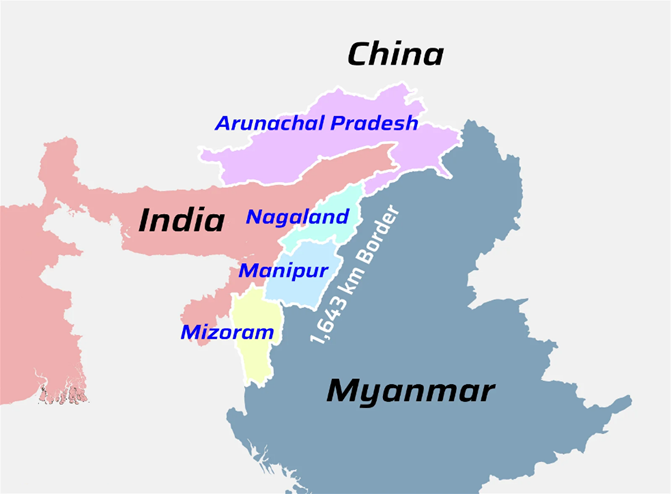MYANMAR NEEDS EXTERNAL HELP, INCLUDING INDIA’S SUPPORT
Relevance: GS 2 – Effect of policies and politics of developed and developing countries on India’s interests
Why in the News?
- Approximately 70 civilians have died while peacefully protesting against Myanmar’s military.
- The military coup in February 2021 initiated violent conflicts across the country. Myanmar has been embroiled in internal conflict for the past three years.
- Resulted in a de facto division: One Section ruled by the military government known as the State Administration Council (SAC). Another section controlled by the
- The Resistance believes the tide is now turning in its favor.
- Aggravation of the crisis in Myanmar poses a threat to regional peace and progress. India’s eastern neighborhood cannot afford this calamity.
UN Secretary-General Antonio Guterres’ March 18 Assessment
- Expressed deep concern about the deteriorating situation and escalation of conflict in Myanmar.
- Highlighted two alarming trends:
- Expansion of Conflict in Rakhine State
- Known for its pre-existing vulnerabilities and discrimination.
- Poses the danger of further incitement of communal tensions.
- Forcible Recruitment of Youth into the Military
- Under the new conscription law in various regions and states.
- Expected to aggravate the crisis.
- Expansion of Conflict in Rakhine State
UN Special Rapporteur Tom Andrews’ Observations
- Reported a fivefold increase in air strikes by the military on its people in the past five months.
- Estimated Humanitarian Crisis:
- 7 million people displaced.
- Another 1 million likely to become displaced by the end of 2024.
- 6 million people, including six million children, in need of humanitarian assistance.
- Highlighted Aid Challenges:
- Minimal flow of aid to the affected regions.
- Aid donors facing logistical challenges in a nation ravaged by conflict.
Myanmar as a Regional Problem
- Consequences vs. Causes: Myanmar is viewed as a regional problem due to its consequences, not its internal causes.
- State Administration Council (SAC):
- Initiated the conflict and is now in decline.
- Faces “an existential threat” according to some observers.
- Despite failures, it remains a tenacious entity.
- Resistance:
- Shows a triumphant spirit but suffers from internal divergences and lack of cohesion.
- Neither side seems likely to achieve an outright victory using military means.
- Both parties need to recognize their shared national identity and work towards reconciliation.
Role of Aung San Suu Kyi
- Aung San Suu Kyi, currently serving a 33-year-long imprisonment, and the National League for Democracy (NLD), which won a landslide victory in the November 2020 elections, are largely absent from the current discourse.
- Suu Kyi potentially holds the key to a political solution to the crisis.
Challenges in De-escalation
- Experts believe that due to prevailing animosities:
- Myanmar’s stakeholders cannot find ways to de-escalate violence and ensure smooth delivery and distribution of humanitarian assistance.
- The SAC and the Resistance are too entrenched in hostility to agree on a relief strategy for the people.
- ASEAN’s Five Point Consensus (FPC)
- The FPC, agreed upon in April 2021 by ASEAN, has failed to deliver despite its best efforts.
Solutions to the Challenges
- External Assistance Needed:
- Myanmar’s ASEAN partners and neighboring countries like China, India, and possibly Bangladesh are essential for providing external help.
- A mechanism should be established to craft a program to alleviate people’s hardships.
- Measures by Thailand: Thailand’s new government is prepared to take steps like Proposing the creation of a “humanitarian corridor” inside Myanmar as a pilot project.
- Myanmar’s Return to Normalcy: Two Contrasting Positions to Reconcile.
- SAC’s Position
- Insistence on retaining the 2008 constitution.
- Proposing restoration of limited democracy after “controlled” elections.
- Resistance’s Vision
- Advocating for a fully federal democratic union.
- Seeking an apolitical military under a new constitution.
- Need for Dialogue Mechanism:
- Before a peace formula can be developed, an innovative mechanism for dialogue among all relevant players is crucial.
- SAC’s Position
India’s Potential Role and Responsibility
- India’s Involvement:
- As a major, interested, and affected neighbor, India has a significant role to play.
- Recommendations for India:
- India’s Myanmar experts should develop practical and pragmatic proposals.
- Proposals should be based on an accurate understanding of power dynamics, geopolitical play, and Myanmar’s history.
- Advisory Role:
- India’s experts can advise policymakers in New Delhi.
- They can also help shape the regional approach to resolving the crisis in Myanmar.
- Regional Implications:
- The aggravation of the crisis in Myanmar threatens regional peace and progress.
- India’s eastern neighborhood cannot afford such a calamity.
Source: https://indianexpress.com/article/opinion/columns/peace-myanmar-outside-help-friends-india-9257002/
Mains question
Discuss the escalating crisis in Myanmar and its regional implications. Highlight the role India could play in resolving the conflict, considering the internal dynamics and geopolitical factors. (Word Limit: 250 words)




